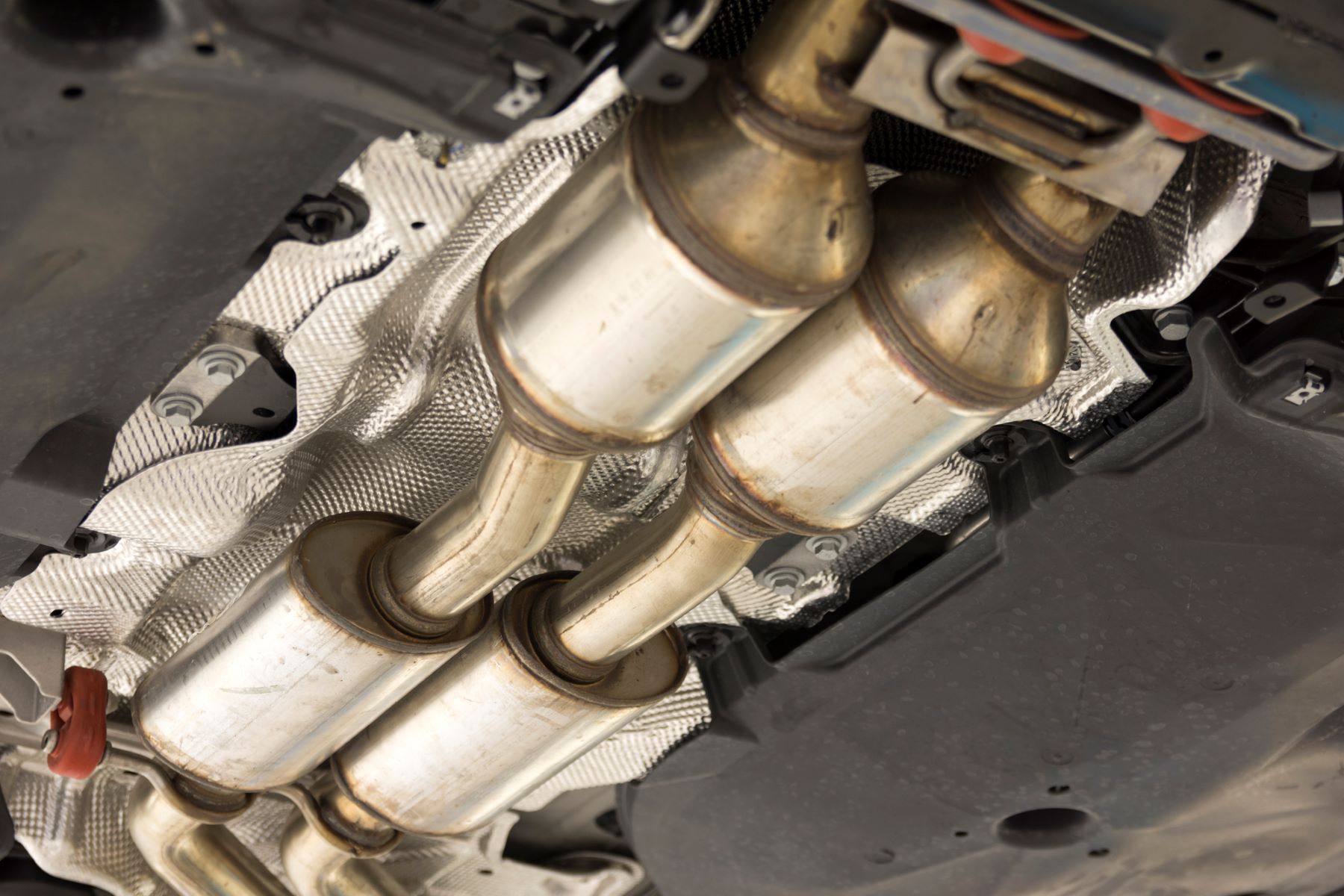Home>Automotive>Quick And Easy Solution To Drain Overfilled Transmission Fluid!


Automotive
Quick And Easy Solution To Drain Overfilled Transmission Fluid!
Published: January 23, 2024
Looking for a quick fix for overfilled transmission fluid? Our automotive experts have the solution you need. Get back on the road in no time!
(Many of the links in this article redirect to a specific reviewed product. Your purchase of these products through affiliate links helps to generate commission for Regretless.com, at no extra cost. Learn more)
Table of Contents
Introduction
Overfilled transmission fluid can lead to a myriad of issues, ranging from decreased performance to potential damage to the transmission system. It's a common problem that can occur during routine maintenance, and it's crucial to address it promptly to prevent further complications. Fortunately, there are quick and easy solutions to remedy this issue, ensuring the optimal functioning of your vehicle's transmission.
In the following sections, we will explore the signs that indicate an overfilled transmission fluid, the potential consequences of this condition, and most importantly, the step-by-step process for draining the excess fluid. By the end of this article, you will have a comprehensive understanding of how to tackle this issue effectively, allowing you to maintain your vehicle's transmission system in top-notch condition.
Signs of Overfilled Transmission Fluid
Identifying the signs of overfilled transmission fluid is crucial for maintaining the health of your vehicle's transmission system. Here are some key indicators that may point to an overfilled transmission fluid situation:
-
Fluid Leaks: An overfilled transmission may result in leaks from the seals or gaskets. The excess pressure caused by the overfilled fluid can lead to the failure of these components, resulting in noticeable leaks underneath the vehicle.
-
Difficulty Shifting Gears: Overfilled transmission fluid can lead to erratic shifting patterns. You may experience difficulties when shifting gears, such as delayed engagement or abrupt gear changes. This can significantly impact the driving experience and should be addressed promptly.
-
Transmission Slipping: Overfilled fluid can cause the transmission to slip, leading to a lack of power delivery to the wheels. This may manifest as a sensation of the engine revving without a proportional increase in vehicle speed, indicating a potential issue with the transmission fluid levels.
-
Unusual Noises: An overfilled transmission can create unusual noises, such as whining or humming, during operation. These noises may indicate excessive fluid pressure or aeration within the transmission system, signaling the need for immediate attention.
-
Fluid Foaming: Overfilled transmission fluid can result in foaming, which occurs when the fluid becomes aerated due to excessive levels. This foaming can impair the fluid's lubricating properties and lead to increased heat generation within the transmission.
-
Transmission Overheating: Overfilled fluid can contribute to increased operating temperatures within the transmission. If you notice the transmission temperature gauge indicating higher-than-normal temperatures, it could be a result of overfilled fluid impeding the cooling and lubrication processes.
-
Check Engine Light: In some cases, an overfilled transmission can trigger the vehicle's onboard diagnostics system to illuminate the check engine light. This serves as a warning signal for various potential issues, including those related to the transmission fluid levels.
By being vigilant for these signs, you can promptly address any overfilled transmission fluid issues, thereby preserving the integrity and performance of your vehicle's transmission system.
Consequences of Overfilled Transmission Fluid
Overfilled transmission fluid can have detrimental effects on the overall performance and longevity of the transmission system. Understanding the potential consequences of this condition is essential for vehicle owners and maintenance professionals. Here's an in-depth look at the ramifications of overfilled transmission fluid:
-
Increased Fluid Pressure: When the transmission fluid is overfilled, it can lead to a surge in hydraulic pressure within the transmission system. This heightened pressure can strain the seals, gaskets, and other internal components, potentially causing leaks and compromising the integrity of the transmission.
-
Aeration and Foaming: Excessive fluid levels can result in aeration and foaming of the transmission fluid. This occurs when air becomes trapped in the fluid, leading to reduced lubricating capabilities and increased susceptibility to overheating. The formation of foam can also diminish the fluid's ability to transfer power effectively, impacting the transmission's performance.
-
Poor Heat Dissipation: Overfilled transmission fluid can impede the system's ability to dissipate heat efficiently. As a result, the transmission may experience elevated operating temperatures, which can accelerate wear and tear on critical components, including clutches, bands, and the torque converter.
-
Degraded Lubrication: Overfilling the transmission can compromise the fluid's lubricating properties. The excess fluid may agitate and aerate, reducing its ability to provide adequate lubrication to moving parts. This can lead to increased friction and wear, potentially resulting in premature component failure.
-
Erratic Shifting Behavior: Overfilled transmission fluid can cause erratic shifting behavior, including delayed or harsh gear engagements. This can lead to a less predictable driving experience, potentially compromising vehicle safety and drivability.
-
Seal and Gasket Damage: The increased pressure resulting from overfilled fluid can damage seals and gaskets within the transmission system. This can lead to fluid leaks and, if left unaddressed, may result in more extensive damage to the transmission over time.
-
Potential Transmission Damage: Prolonged operation with overfilled transmission fluid can ultimately lead to internal damage within the transmission. The additional stress placed on various components, coupled with the compromised lubrication and cooling properties, can contribute to premature wear and potential failure of critical parts.
Understanding these consequences underscores the importance of promptly addressing overfilled transmission fluid to mitigate potential damage and maintain the optimal functionality of the transmission system.
Quick and Easy Solution to Drain Overfilled Transmission Fluid
Addressing an overfilled transmission fluid situation requires a systematic approach to ensure the proper functioning and longevity of the transmission system. Here's a step-by-step guide to efficiently drain the excess fluid and restore the optimal fluid level:
-
Prepare the Vehicle: Begin by parking the vehicle on a level surface to ensure accurate fluid level readings. Engage the parking brake and chock the wheels to prevent any unintended movement. It's essential to perform this procedure in a safe and controlled environment.
-
Locate the Drain Plug: Refer to the vehicle's service manual to locate the transmission fluid drain plug. The drain plug is typically situated on the transmission pan or housing. It's crucial to identify the correct drain plug to avoid inadvertently draining other vital fluids.
-
Gather Necessary Tools and Equipment: Before proceeding, gather the required tools and equipment, including a suitable wrench or socket set to remove the drain plug, a drain pan to collect the excess fluid, and safety gloves to protect your hands from the transmission fluid.
-
Drain the Excess Fluid: With the drain pan positioned beneath the drain plug, carefully loosen the plug using the appropriate tool. Slowly and systematically remove the plug, allowing the excess fluid to drain into the pan. Exercise caution as the fluid may still be hot, posing a risk of burns.
-
Monitor Fluid Flow and Level: As the excess fluid drains, monitor the flow to ensure it is consistent and free from any contaminants or debris. It's also advisable to check the drained fluid's condition, as unusual discoloration or the presence of metal particles may indicate underlying transmission issues.
-
Reinstall the Drain Plug: Once the excess fluid has been drained, clean the drain plug and inspect the sealing washer for any signs of damage or wear. Carefully reinstall the drain plug and tighten it to the manufacturer's specified torque setting to prevent leaks.
-
Refill with the Correct Amount of Fluid: Consult the vehicle's service manual to determine the recommended transmission fluid capacity. Using a funnel, carefully add the appropriate amount of fluid to achieve the correct level. It's essential to use the manufacturer-recommended transmission fluid type to maintain optimal performance and compatibility.
-
Check Fluid Level and Test Drive: After refilling the transmission fluid, use the dipstick or level indicator to verify that the fluid level falls within the recommended range. With the vehicle idling, cycle through the gears to allow the fluid to circulate. Then, take the vehicle for a test drive to ensure smooth and consistent gear engagements.
By following these steps, you can effectively address an overfilled transmission fluid situation, safeguarding the transmission system from potential damage and ensuring reliable performance on the road. Regularly monitoring and maintaining the appropriate transmission fluid levels is paramount for preserving the integrity and functionality of this critical automotive component.
Conclusion
In conclusion, addressing an overfilled transmission fluid situation is essential for maintaining the health and longevity of a vehicle's transmission system. By recognizing the signs of overfilled transmission fluid, including fluid leaks, shifting difficulties, transmission slipping, unusual noises, fluid foaming, overheating, and check engine light illumination, vehicle owners and maintenance professionals can promptly identify and rectify this common issue.
Understanding the potential consequences of overfilled transmission fluid, such as increased fluid pressure, aeration and foaming, poor heat dissipation, degraded lubrication, erratic shifting behavior, seal and gasket damage, and potential transmission damage, underscores the critical need to address this issue proactively.
The step-by-step solution to drain overfilled transmission fluid provides a practical and efficient approach to rectifying the situation. By preparing the vehicle, locating the drain plug, gathering the necessary tools and equipment, draining the excess fluid, monitoring fluid flow and level, reinstalling the drain plug, refilling with the correct amount of fluid, and verifying the fluid level and performance through a test drive, vehicle owners and maintenance professionals can effectively restore the transmission fluid to the optimal level, ensuring the continued reliability and performance of the transmission system.
Maintaining the appropriate transmission fluid level is paramount for preserving the integrity and functionality of this critical automotive component. Regular monitoring and maintenance of the transmission fluid level, in conjunction with routine transmission inspections and servicing, can contribute to the overall health and performance of the vehicle's transmission system.
By remaining vigilant for the signs of overfilled transmission fluid and promptly addressing any issues, vehicle owners can safeguard their transmission system from potential damage, ensuring a smooth and reliable driving experience. Ultimately, a proactive approach to transmission maintenance, including addressing overfilled fluid situations, is integral to the long-term health and performance of any vehicle.















